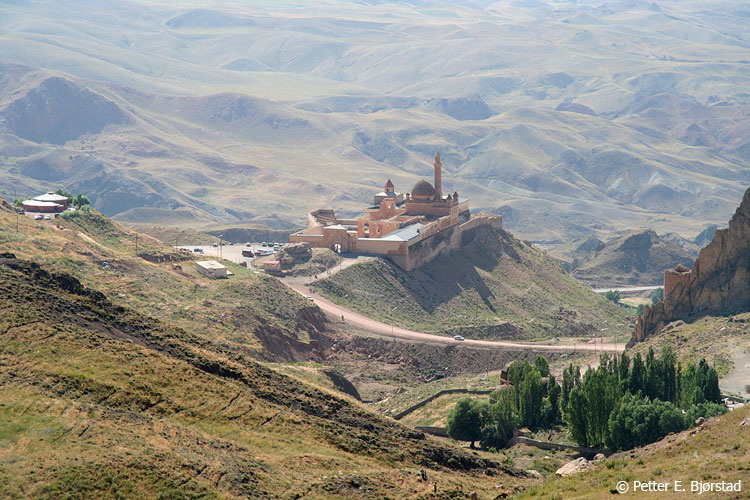 |
| İshak Paşa Sarayı in Armenia | |||
 |
|
||
| Der Palast | |||
|
The Ishak Pasha Palace is a castle-like palace of the Ottoman Emir of Doğubeyazıt, Çolak Abdi Paşa and his son İshak Paşa II. It is located in the far east of Turkey about six kilometers southeast of the city Doğubeyazıt, built between 1685 and 1784.
|
|||
|
|
|||
|
The palace is located on the promontory of one of these ridges at about 2200 meters above sea level, about four kilometers south of the highway. Passing the former urban settlement below the palace, the old trade route, part of the Silk Road, led to Tabriz in Iran. |
|||
|
|
|||
|
The outer walls of the complex rise on three sides directly above the steep slope. Access is from above via the ridge, where the road ends above. An Ottoman dome mosque from the 16th century can be seen a few 100 metres north of the palace in a side valley. Above the mosque and beyond the valley basin, the medieval fortress of the town sits enthroned on a steep rocky ridge near a primeval rock tomb. In the valley, a stream flows from east to west. It used to provide the inhabitants of the palace with drinking water, which was collected in a basin north of the palace. There used to be a water spring near the village of Kivi, two kilometres to the south-east. The plateau of Doğubeyazıt is otherwise water-poor, almost treeless and because of the only thin layer of earth unsuitable for agriculture. |
|||
|
|
|||
|
The portal |
|||
|
|
|||
|
In 1956 the regional monument protection authority (Anıtlar ve Müzeler Genel Müdürlüğü) started an initial investigation. They measured the plant for several months and made drawings. Its director Mahmut Akok published a detailed report on this in 1960 and clean-up work began around 1963. In 1966 the restoration work on the eastern and southern enclosure wall was completed. The masonry of the palace was largely restored until the 1980s. |
|||
|
|
|||
|
|
|||
|
Passage into the courtyard |
|||
|
|
|||
|
|
|||
|
Kümbet in front of the northern facade of the second courtyard |
|||
|
|
|||
 |
|||
|
|
|||
|
In 1992, extensive restoration work was initiated by the Ministry of Culture. The wall sections supplemented with concrete in previous years were removed and replaced by more suitable lime mortar and hewn field stones. In 2004 it was discovered during static investigations that incorrectly installed steel anchors led to damage to the outer walls. Cracks in the mosque walls had to be closed. In 2009, the rooms, which were provisionally covered during the restoration with flat sloping corrugated iron roofs, and the other parts of the building, which had remained open in the 1980s, were lavishly covered with a barrel vaulted wooden beam and glass construction. The glass keeps rain and snow out and protects against overheating in summer with a built-in UV filter. |
|||
|
|
|||
|
|
|||
|
The Ottoman dome mosque, above it a medieval fortress |
|||
|
An Ottoman dome mosque from the 16th century can be seen a few 100 metres north of the palace in a side valley. Above the mosque and beyond the valley basin, near a primeval rock tomb, the medieval fortress of the town sits enthroned on a steep rocky ridge. |
|||
| Photos: Monika P., Petter E. Bjørstad | |||
| Translation aid: www.DeepL.com/Translator | |||
| Source: Wikipedia and others | |||
|
|
|||

